The "Boneyard" Of Davis-Monthan Air Force Base Is Open For Tours
For those who are interested in aviation history, it's worth visiting the Davis-Monthan Air Force Base for a tour of this plane 'boneyard.'
The Davis-Monthan Air Force Base is one of a kind and certainly a wonder to behold. It is a US Air Force base 5 miles southeast of downtown Tucson, Arizona, and is famous for its massive aircraft boneyard for storing American military aircraft. The Davis-Monthan Air Force Base is the destination for all American excess military and aerospace craft.
Tuscon is an interesting city, and there is plenty to keep one busy if coming to visit for the weekend. Incorporate the Air Force Base and museum into one's trip to Tuscon and one will have a very memorable time here . Another American (but top secret) base that we all wish we knew more of is the famed Area 51 - home to those crashed little green men .

About The Davis-Monthan Air Force Base
As the sole aircraft boneyard for excess military aircraft is full of thousands of military airplanes of every sort imaginable. It also stores other aerospace vehicles like ballistic missiles.
- 4,000: Number of Military Aircraft Parked on the Base
Tuscon's dry climate and alkali soil make it an ideal location to store and preserve unused aircraft.
The 309th Aerospace Maintenance and Regeneration Group (AMARG) is responsible for reserving these excess aircraft was established in 1946. It occupies some 2,600 acres and houses every kind of American military aircraft one can think of. To name a few that one can see:
- B-52 Stratofortress Bombers
- F-16 Fighting Falcons
- A-10 Warthogs
- C-130 Hercules
- B-1B Lancers
Storage Categories
The boneyard has the following official categories for how it stores the aircraft:
- Type 1000: Long Term Storage, Maintained Until Recalled into Active Service, They Have a High Potential to Return To Flying Status And No Parts Are Removed
- Type 2000: Aircraft Available for Part As "Aircraft Storage Bins" To Keep Other Aircraft Flying
- Type 3000: "Flying Hold" Kept to Near Flyable Condition - In Temporary Storage Awaiting sale To Another Country or Transfer to Another Unit
- Type 4000: Excess Of Needs And Have Been Gutted And Every Usable Part Has Been Reclaimed. To Be Scrapped
It is the foremost facility for the maintenance, salvage, and storage of military aircraft in the world.
This is a very active site and not an abandoned site that one may be tempered to sneak into. It is very much guarded by armed security and airforce personal.
Related: Go UFO Hunting In Roswell, New Mexico, And Then Check Out Their UFO Museum
Davis-Month Air Force Base Tour
The Davis-Month Air Force Base offers a tour of their air force base (but not the neighboring boneyard.
The 355th Wing offers group tours with the aim of educating people about the US Air Force and its missions. They do not accommodate individuals or non-organized groups. But they do try to accommodate specific requests to visit a particular unit or learn about certain missions.
These tours are only provided to organized groups like civic organizations, schools, businesses, and reunion groups.
If one would like a tour, one must complete the " Community Relations Request Form " and e-mail it to [email protected] at least 4 weeks or more before the intended date.
- Organized Groups Only: No Private Tours
- Limit: Tours Are Limited to a Minimum of 20 People and a Max of 45 (or the Capability of One Commercial Bus)
- When: Tours Are Only Offered On Weekdays
- Duration: Tours Are Max 4 Hours
- Age Limit: Only 18 And Over (ID Is Required)
- Dining: There are Dining Options On The Bace Like Mirage Club andEagle's Nest Snack Bar & Grill
Related: This Is What Air Force One Serves As Its Halloween In-Flight Meal
Pima Air & Space Museum & Former Boneyard Tours
On-site is the impressive Pima Air & Space Museum . It offers some very impressive Air Force exhibits and until recently offered exclusive bus tours of the 309th Aerospace Maintenance and Regeneration Center (AMARG) - aka the 'boneyard'. It is located adjacent to the Museum at Davis-Monthan Air Force Base.
Admission to the museum itself includes access to the Main Hangar (3 hangars combined into 1: Hangar 1, Spirit of Freedom, & Flight Central), three World War II Hangars, the 390th Memorial Museum (a separate museum on our grounds), a collection of 400+ aircraft and 125,000+ artifacts, and more.
They offer a 45 minute Tram tour through the museum's 80 acres on a 1.5-mile circuit that views over 150 airplanes in their collection. The Tram Tours are narrated by experienced and friendly guides that explain the various highlights of the collections.
Narration may include the plane’s significance, and often times share their personal stories of service with many of the aircraft on display.
- Museum Admission: Adult (Age 13+) $18.50 - 1 Day or $24.00 2 Days
The Air Force 309th section of the base includes the massive boneyard. Unfortunately, they no longer provide tours of the 'Boneyard'. They did offer visitors for nearly 23 years but now tours are canceled. Perhaps they will offer them once again in the future. They recommend those interested in learning more about the Boneyard to visit their Facebook page .
Next: See The Best Of The Sonoran Desert In The Saguaro National Park
Your browser is not supported for this experience. We recommend using Chrome, Firefox, Edge, or Safari.
- General Admission
- Directions and Hours of Operation
Available Tours
- Group Booking
- Private Event Planning
- Museum Aircraft
- Live Stream
- Virtual Meeting Backgrounds
- School Groups
- Scouts/Youth Groups
- Homeschool Groups
- Education Resources
- On & Off-site Classes
- Guided Tours
- Night Wings - 6/15, 6/29, 7/13, 7/27
- Pilot Exploration - 6/26-28 (Summer Camp)
- Arizona Aerospace Foundation
- Arizona Aviation Hall of Fame
- News and Media Center
NOTICE: t he bus tours to Davis-Monthan AFB of the 309 th AMARG (AKA “The Boneyard”) have permanently ende d. This tour is no longer offered and will not be coming back due to changes in U.S. Air Force security considerations.
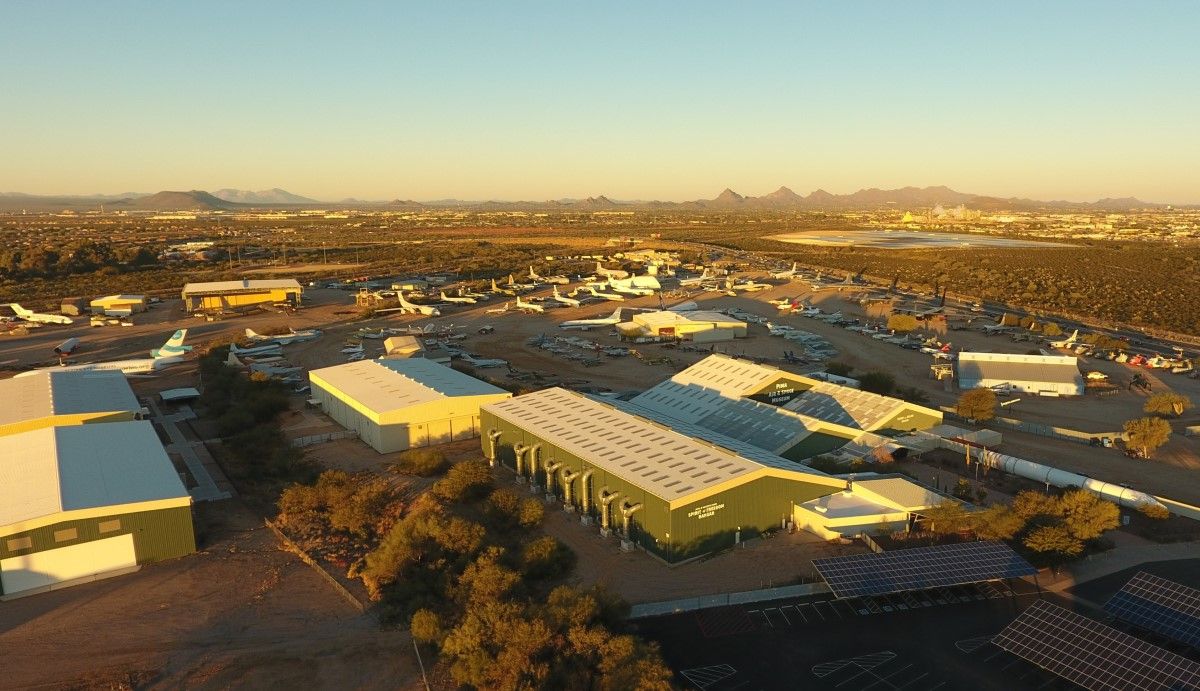
Public Tram Tours
Price: $ 8 per person with admission to the museum.
Duration: 45 minutes non-stop
Tickets: Tickets for the public trams are sold at admissions only.
Tour Times: Times change daily, please check with admission upon arrival to the Museum.
The Tram Tours are currently offered daily. All Tram Tours and tour times are subject to selling out, change or cancellation due to weather/mechanical/personnel/late arrivals, or other conditions beyond PASM control .
The Tram Tour is a 45 minute narrated tour of the planes located in the outdoor display area of Pima Air and Space Museum. This tour will take passengers through the museum’s 80 acres on a 1.5 mile circuit. Passengers will view more than 150 planes in our collection and hear highlights of our more significant aircraft.
Additional Information:
- Children 2 and under are considered a lap child and do not require a tram ticket (limit one per paying adult).
- This tour requires physically stepping up (2 to 4 steps) onto the tram.
- Wheelchair Accessible trams available upon request at time of purchase.
- Tram Tickets can not be purchased or booked in advanced.
- There is a limited number of tram seats sold per day. All tickets are sold on a first come, first serve basis.
- While leashed pets are welcome at the museum, we do not allow them on the tram tour, with the exception of service animals.
- Please note: This tour is located on the grounds of Pima Air and Space Museum and will not include the AMARG (AKA the Boneyard) located on Davis Monthan Airforce Base. We can not accommodate any request for private tours of the AMARG facility.
Private trams are available for groups booking within two weeks of their visit date. Please visit our group booking page under plan your visit to book this tour.
Private Tram Tours
Price: $ 350 per group plus admission to the museum per person.
Reservations: must be made a minimum of two weeks in advance using our online booking system.
Capacity : a max of 35 participants per tram
- If your group has more then 35 participants and are arriving on a bus, we can accommodate the tram tour using your bus. Please email [email protected] for more information about bus tour options.
9:45 am 2:30pm (October – May)
- Private tram tours are not available on Mondays.
- The museum can only accommodate one Tram Tour per time slot. If your group exceeds the number of seats available on a tour, you will need to book the second time slot for the day. Requests to run back-to-back tours or tours outside of the pre-selected time slots cannot be accommodated.
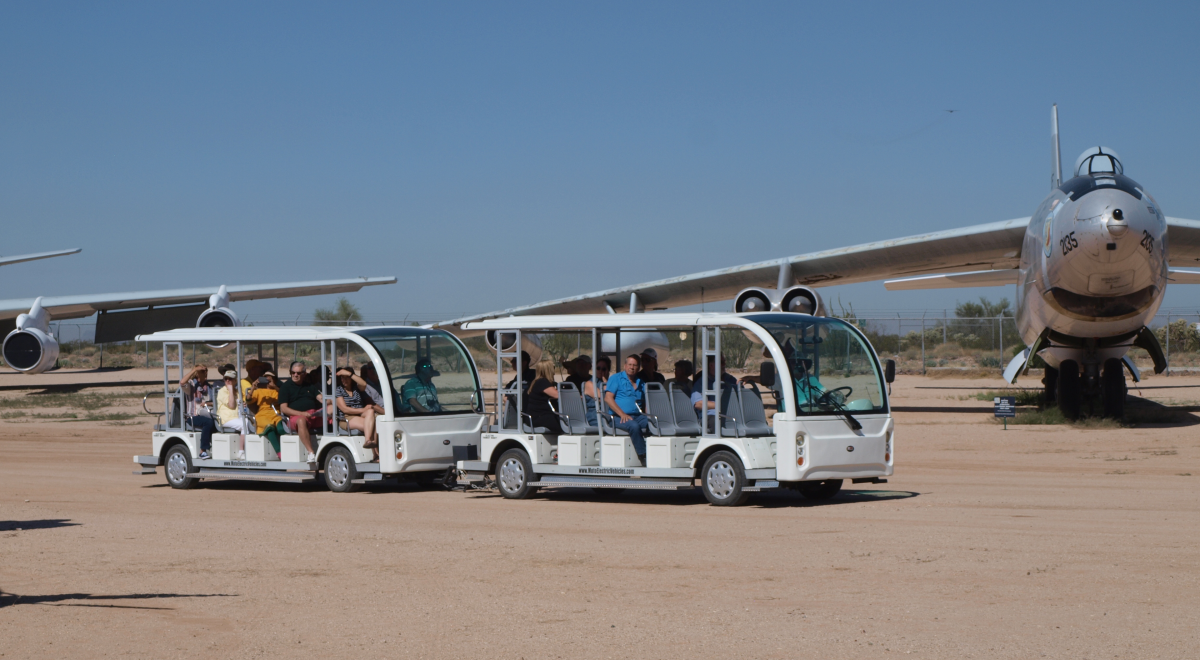
AUDIO TOURS
Price: $5 per device plus general admission
Times: 7 days per week, based on device availability
Guests can check out an audio tour device and explore the museum at their leisure. Throughout the museum, there are signs that indicate artifacts and exhibits that are part of the Audio Tour. Guests point their device at the signs, and audio will begin playing. Narrated by museum staff, the audio guides provide an in-depth description and history of some of our significant aircraft and exhibits. Narrations include the B-24 Liberator, the Hind helicopter, an Air Force One, the Super Guppy, and so much more!
For a seamless listening experience, we recommend one device for every two people in your group (though more people can listen at a time).
While not required to hear the audio tour, the devices are compatible with headphones/earbuds that have a jack (not compatible with wireless devices), and the museum has earbuds for purchase for $1. You may also provide your own.
Devices are available to check out at the counter in admissions. They are available on a first come, first served basis, and cannot be reserved ahead of time.
Private Walking Tours
These are guided walking tours that last 45 minutes. We offer four different themes: Aviation Highlights, WWII, Cold War, and Walk of Fame. Your group will pick the theme for your tour. Descriptions of the themes are listed below. After the tour, guests will be able to explore the rest of the museum at their leisure.
Price: $75 per group plus admission
Times: 9:30am, 11:00am, 1:00pm and 2:30pm – Reservations Required
Aviation Highlights Tour (Hangar 1) Your group will be guided through our largest hangar which contains some of the museum’s most popular aircraft! On this tour, you will see aircraft like the SR-71, the F-4 Phantom II, and the world’s smallest biplane, the Bumblebee. This tour will meet in Hangar 1 in front of the Wright Flyer.
World War II Tour (Hangars 3,4 &5) Your Group will be guided through our 3 WWII hangars. You will learn about planes like the B-29, Catalina, and P-51. This tour will meet in Hangar 5 located on the south side of the museum.
Cold War Tour (Hangar 1) Your group will be guided through the main hangar and discuss aircraft and artifacts from the Cold War Era. Topics include military demonstration aircraft, the Huey, nuclear weapons, submarine hunting aircraft, and of course, the SR-71 Blackbird. This tour will meet in Hangar 1 in front of the Blue Angels F-11 Tiger.
Walk of Fame (Hangar 1, Outside, and Aerospace Gallery) Your group will be guided through various hangars and outside to view iconic and record-breaking aircraft, pop culture aircraft, and aircraft types used by celebrities like John Denver, Jim Croce, Harrison Ford, and Led Zeppelin. Aircraft discussed include the Rutan Long EZ, the Westland Lynx, the F-14 Tomcat, and the A-4 Skyhawk. This tour will meet in Hangar 1 in front of the Wright Flyer.
Important information:
- All guest participating on this tour must purchase admission to the museum.
- Tours reservations must be made a minimum of 5 days in advanced
- Tours offered 7 days a week.
- Maximum Participants per tour is 35. Groups large then 35 participants will need to book multiple tours to accommodate their group size.
Please note: This tour is located on the grounds of Pima Air and Space Museum and will not include the AMARG (AKA the Boneyard) located on Davis Monthan Airforce Base. We can not accommodate any request for private tours of the AMARG facility.
Please visit our group booking page to book this tour or for more information please email [email protected] .
Custom Private Tour
In this custom tour, you will be able to choose 4 topics that your guide will cover during your tour. Depending on the topics you choose, the tour may be a walking tour, tram tour, or a mix of both, as some of the aircraft available for this tour are located outside. Before and after the tour, guests will be able to explore the rest of the museum at their leisure.
Price: $150 per group plus admission.
Times: 10:30am or 1:00pm- Reservations Required
- Tours are available Tuesday-Sunday. We are unable to accommodate custom tour requests on Mondays.
- Duration: 45 minutes-1 hour
- Limit 15 people per group.
- You must book at least two weeks in advance.
Available Topics Below is a list of available topics and the aircraft included in that topic. An asterisk indicates aircraft that are found outside. You can choose 4 topics for your custom tour.
- Aircraft Icons : Wright Flyer, F-14 Tomcat, UH-1 Huey, SR-71 Blackbird
- WWII Europe : Hawker Hurricane, B-24 Liberator, IL-2 Shturmovik, V1 Buzz Bomb
- WWII Pacific 1 : F4U Corsair, P-51 Mustang, B-29 Superfortress, Ohka (kamikaze display)
- WWII Pacific 2 : PBY Catalina, B-25 Mitchell, P-40 Warhawk (Pearl Harbor), Ki-43 Hayabusa
- Korean War – HTL-2 Sioux, F7F Tigercat, MiG 15, F-86 Sabre
- NASA Space Program : Mercury Capsule, Apollo Command Module, Space Shuttle Trainer, X-15 Rocket Plane
- Air Force Fighters *: F-102/106 Delta Dart/Dagger, F4 Phantom II, F-15 Eagle, F-105 Thunderchief
- Navy/Marine Aircraft *: F/A-18 Hornet, A-4 Skyhawk, A-6/EA-6 Intruder/Prowler, F9F Panther
- Bombers *: B-36 Peacemaker, B-52 Stratofortress, B-58 Hustler
- Foreign Aircraft *: SEPECAT Jaguar, English Electric Lightning, Dassault Mirage, MiGs
- Helicopters *: Mi-24 Hind, CH-54 Tarhe (Skycrane), MH-53/CH-37 Pave Low/Mojave, AH-1 Supercobra
- Boeing Airliners *: 737, 747, 777, 787
- NASA Aircraft *- Super Guppy, 747 (SOFIA), KC-135, B-52A
- Presidential/VIP Transports *: VC-118 Liftmaster, VC-137 Stratoliner, VH-34 Choctaw, VC-121 Constellation
Important Information
- ALL PARTICIPANTS OF THE CUSTOM TOUR ARE REQUIRED TO PAY GENERAL ADMISSION TO ENTER THE MUSEUM. GROUPS OF LESS THAN 20 WILL NEED TO PAY GENERAL ADMISSION AT THE GATE UPON ARRIVAL.
- We do have a wheelchair accessible tram and can accommodate one guest with a wheelchair per tour if a tram is required. If you have questions or concerns about accessibility for your group, please email [email protected] and we can work with you to design a custom tour that all members of your party will enjoy!
- We recommend you arrive at least 30 minutes early to ensure you have enough time to make your way through the line at admissions and meet your tour guide.
- Please understand that while this is a private tour for your group, the hangars are open to the general public, and they will be present in the hangars during your group’s tour. Your tour guide will prevent the general public from joining your group and keep your tour private to the best of their ability.
Pima Air & Space Museum
Creating unlimited horizons in aerospace education through the preservation and presentation of the history of flight.
Charity EIN: 86-6031135
Copyright © Website by CS Design Studios
Privacy Policy
Contact Info
520-574-0462
6000 E Valencia Rd, Tucson, AZ 85756
Operating Hours: Open 9 AM – 3 PM Daily Last Admittance at 1:30 PM
AIR & SPACE MAGAZINE
A tour of the boneyard.
The aircraft retirement home in Arizona is well worth a visit.
/https://tf-cmsv2-smithsonianmag-media.s3.amazonaws.com/accounts/headshot/Sotham_photo.jpg)
John Sotham
/https://tf-cmsv2-smithsonianmag-media.s3.amazonaws.com/filer/d8/a5/d8a584c7-9477-4b4a-ba2c-90944ea56acb/c-5_boneyard.jpg)
My son Ian and I had already spent two days at the Pima Air & Space Museum outside Tucson, Arizona, walking the hangars and the terrific collection of aircraft parked outside. Pima is adjacent to the fence line of Davis-Monthan AFB, home of the “Boneyard.” Its official name is the Air Force’s 309th Aerospace Maintenance and Regeneration Group—the caretakers of nearly 4,000 U.S. military aircraft headed for scrap, storage, or potential rebirth, all parked on 2,600 acres of Arizona desert.
Boneyard tours are exclusively handled by the Pima museum. You can get tickets online or in person at the gift shop.
Buses to Davis-Monthan depart just outside the Pima main entrance. We queued up—after a check for identification and a cursory bag check—and got onboard to enter the base’s gate. I presented my military ID, and our tour guide, Bob Ratledge, waved us aboard the bus with a few questions (where was I stationed?) and a thanks for my service.
We rolled toward the DM gate. Over the bus’s intercom, Ratledge began his tour and welcomed our international guests (I was amazed at how many were visiting this dusty corner of the U.S.), who came from Italy, Ukraine, and the United Kingdom. After we were inside the base, he gave us a plane-by-plane guide to “Celebrity Row,” a lineup of iconic aircraft retired here.
One of only two YC-14s entered our view—the Boeing counter to the requirement that resulted in the McDonnell-Douglas (ironically, now Boeing) C-17 Globemaster III that flew me to and from Afghanistan. A brooding F-4 came into view (Phantoms always look grumpy to me), the airplane I used to tend to as a young Senior Airman crew chief. There are still a good number of these iconic fighters here, still being converted into target drones, along with more modern, but still outmoded, early-model F-16s.
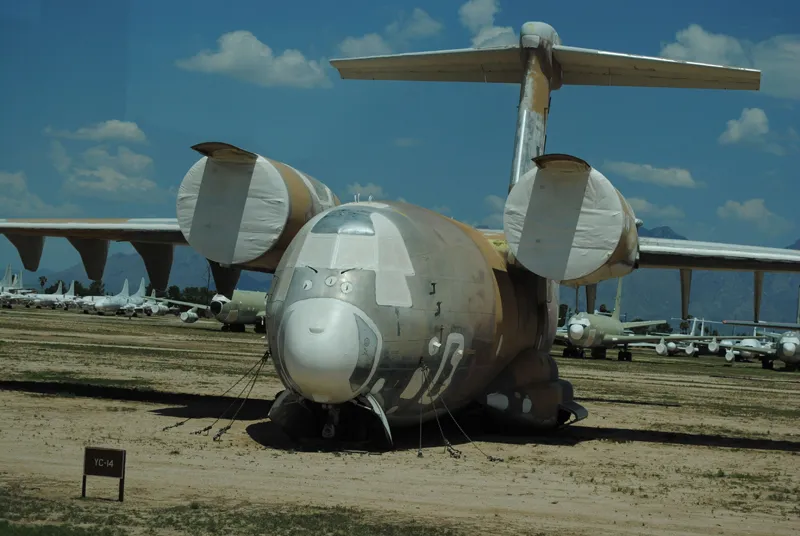
I grew tired of craning my neck to one side (if you’re into fighters, grab a seat on the left side of the bus). My other heartbreak as a former “Warthog” crew chief: Endless rows of deadly tank-busting A-10 Thunderbolt IIs.
Hundreds of C-5s are stored here. For scale, a diminutive T-37 “Tweet” is parked next to the Celebrity Row Galaxy. After the bus passed acres of C-5s, followed by KC-135s, C-130s, HH-60s, and S-3-Vikings, the massive YAL-1 Airborne Laser—a Boeing 747-400 airframe fitted with a high-powered laser capable of downing an incoming missile—came into view. The YAL-1 sits forlorn, engineless and headed for scrap.
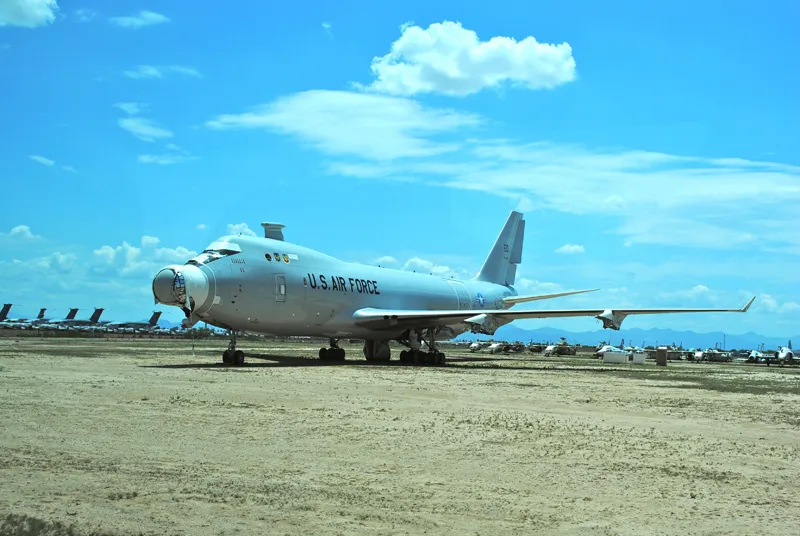
Soon it was time to turn around and head back to Pima, and Ratledge passed the return trip with an intercom quiz about aircraft and World War II history. (Ian shot his hand up to answer after nearly every question.)
If you’re near Tucson, don’t miss Pima or the Boneyard tour. Next stop on our tour: the U.S. Air Force Academy in Colorado Springs, where we’ve got space-available military lodging reservations.
Get the latest stories in your inbox every weekday.
/https://tf-cmsv2-smithsonianmag-media.s3.amazonaws.com/accounts/headshot/Sotham_photo.jpg)
John Sotham | READ MORE
A former associate editor of Air & Space , John Sotham is a hopelessly nearsighted frequent flyer, with thousands of hours logged in exit rows worldwide. He is a retired U.S. Air Force Reserve colonel and a former crew chief on the F-4D Phantom II and A-10A “Warthog.” He started collecting aviation books when he was eight years old. Any opinions expressed are solely the author’s.
Interactive Aerial Tour: Davis-Monthan Aircraft Boneyard in Tucson
The 309th Aerospace Maintenance and Regeneration Group (309th AMARG), [2] often called The Boneyard , is a United States Air Force aircraft and missile storage and maintenance facility in Tucson , Arizona, located on Davis–Monthan Air Force Base . The 309th AMARG was previously Aerospace Maintenance and Regeneration Center , and the Military Aircraft Storage and Disposition Center , and its predecessor was established after World War II as the 3040th Aircraft Storage Group .
The 309th AMARG takes care of nearly 4,000 aircraft, which makes it the largest aircraft storage and preservation facility in the world. An Air Force Materiel Command unit, the group is under the command of the Ogden Air Logistics Complex at Hill Air Force Base , Utah. The 309th AMARG was originally meant to store excess Department of Defense and Coast Guard aircraft, but has in recent years been designated the sole repository of out-of-service aircraft from all branches of the US government. The facility has received US made foreign military aircraft: Boeing CC-137 (from RCAF for use in Joint Stars E-8 program), Lockheed CP-140 (from RCAF). The arid climate of the region makes the 309th AMARG an ideal location for storing aircraft, as there is very little humidity in the air that would corrode metal. Further, the surface is hard so that the aircraft do not sink into the ground.
Related Posts

Points of Interest
Interactive Aerial Tour: Disneyland Park

Interactive Aerial Tour: Champlain Towers South Condominiums

Interactive Aerial Tour: Original Starbucks Store
- Destinations
- North America
Take flight inside the world's biggest plane 'boneyard'

The last flight airplanes make tend to be lonely ones. With no passengers on board, save for the small number of crew required to get them there, they're flown to expansive spaces known as "boneyards" where they stay until they're harvested for parts or scrapped.
- Sightseeing

Usually in the desert to prevent or slow rusting, boneyards are like retirement communities for out-of-service commercial, private and military planes. There are dozens of them across the USA, Europe, and even one in the Northern Territory here in Australia holding hundreds of long-since-forgotten aircraft.
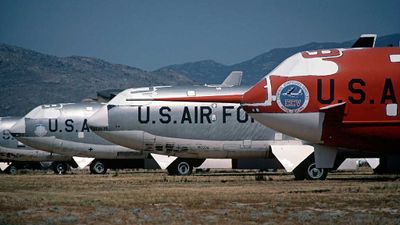
Arizona's Davis-Monthan Air Force Base – colloquially known simply as The Boneyard – takes the title of world's largest, with upwards of 4400 decommissioned military and space aircraft parked in highly organised rows across its 10.5-square-kilometre space just outside Tucson.
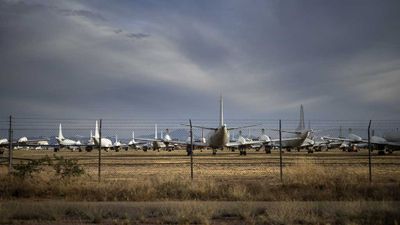
Established in 1946 following the end of WWII, The Boneyard's dystopian aesthetic has formed the backdrop for a number of television shows, music videos and movies, including Transformers: Revenge of the Fallen .

Here, the 309th Aerospace Maintenance and Regeneration Group (AMARG) take care of the aircraft, which include cargo planes and Hercules freighters, B-52 bombers, A10 Thunderbolts, and F-14 Tomcat fighters of Top Gun fame. Well-worn footpaths suggesting they've been stationary for a long time surround them.
Image: Google Maps
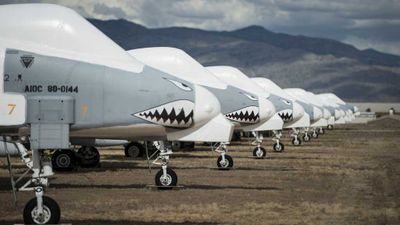
While the planes are more or less in-tact, some are missing noses or wings, while B-52s, for example, had major parts removed to prove to Russian authorities using satellites that they were no longer in service.
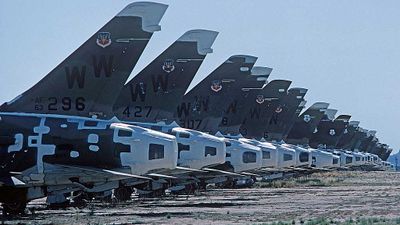
Upon arrival at The Boneyard, planes are washed before their fuel tanks are drained and cleaned, ducts are sealed, and ammunition and ejector seats are removed.

Tourists can visit The Boneyard, with tours departing from the nearby Pima Air and Space Museum from Monday to Friday. As it's a functional base, tickets can only be purchased by people aged 16 years and older, and government-issued ID must be presented at the time of purchase.
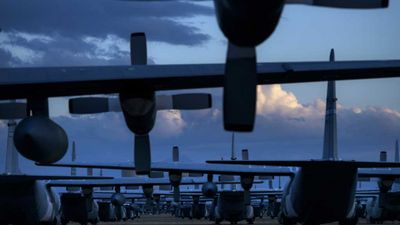
Tickets cost $9 (US $7) for adults and $5 (US $4) for children, and can only be purchased at the museum at 6000 East Valencian Road in Tucson. Tours depart at 11am and 2pm, with buses loaded 15 minutes before the scheduled departure time.
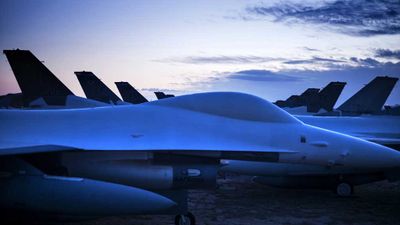
Visit the website or call +1 520 574 0462 for more information.
National Association of Rocketry
NARCON 2020
Air force “boneyard”.
This is an excerpt from the Airplaneboneyards.com website. Davis-Monthan AFB’s role in the storage of military aircraft began after World War II, and continues today. It has evolved into “ the largest aircraft boneyard in the world “.
With the area’s low humidity in the 10%-20% range, meager rainfall of 11” annually, hard alkaline soil, and high altitude of 2,550 feet allowing the aircraft to be naturally preserved for cannibalization or possible reuse, Davis-Monthan is the logical choice for a major storage facility.
Please be advised of the following:
- Reservations are required a minimum of 16 business days in advance of the desired tour date and can be made up to 60 days in advance.
- The tour is non-transferable and non-refundable
- ID information is required for all tour participants, including minors, no later than two weeks prior to the tour date
- Please see https://pimaair.org/visit/boneyard-reservation-request/ for specifics on ID requirements—scroll to the “Additional Information” headline at the bottom of the linked page
- The tour is handicap accessible but requires notification at the time of the reservation
Take a look at the Davis-Monthan Air Force base.
- My Membership
- American Rocketry Challenge
- The Sport Rocketry Hobby
- Model Rocket Safety Code
- Understanding FAA Regulations
- High Power Rocketry Certifications
- High Power Rocket Safety Code
- Filing for FAA Launch Authorization
- High Power Technical Reports
- NAR HPR Certified Member Search
- The NAR Rocket Science Achievement Award
- Online Mentoring Resources
- NARTREK Skills Program
- The NARTREK Cadet Program
- Air Force JROTC
- Civil Air Patrol
- Rocket Teacher Certification Program
- Grants, Scholarships, and Recipients
- Educator’s Newsletter Archive
- Listed Launches (Searchable)
- Launch Calendar
- Register an NAR Launch
- NAR Club Locator
- Find an NAR Club Launch
- Submit a Local Club / Submit Changes
- Section FAQ’s
- Section Guidebook
- Insurance Questions/Claims
- Safety Codes
- Radio Control Rocket Glider Safety Code
- Motor Related Lists
- NAR Motor Testing Notices
- Manufacturer Notifications
- Report a Malfunctioning Motor
- National Scoreboard
- US Team Selection Scoreboard
- Competition Results Entry
- Team Registration
- Contest Events
- Competition Meets
- International Competition
- Competition Guide
- U.S. Model Rocket Sporting Code
- Rules Revision Process
- US National Model Rocket Performance Records
- Magazine Submissions
- Write It and Get Paid
- Advertise in Sport Rocketry
- Sample Issue
- Contact Sport Rocketry
- Members Only Forum
- Sport Rocketry Magazine
- eRocketeer Digital Editions
- Member Guidebook Archive
- American Spacemodeling Magazine
- The Model Rocketeer Magazine
- Model Rocketry Magazine
- R&D Reports
- Technical Bibliography
- Insurance Questions
- Proof of Insurance
- NAR Insurance Claim Form
- NAR Association Documents
- NAR Products
- Website Fixes
- What’s My NAR Number?

Boneyard Safari Preserving Aviation HIstory
Hands on tour & special events, once a month the boneyard safari provides a hands on tour in conjunction with aircraft restoration management in tucson. .
Take a unique tour and see a side of aviation with an exclusive look through aircraft in their different conditions at Aircraft Restoration Marketing, which is one of the last regeneration facilities in Tucson. Boneyard Safari Docents will guide 10 guests through a C-130, DC-3/C-47, Boeing 727, and walk around various other aircraft including a C-27A, T-37, C-131F, and P-3. It is limited to 3 hours due to weather conditions. Bring your cameras because this is a unique opportunity to go inside of aircraft as they are being regenerated or seeing their final days. Be prepared for hot weather, so bring a hat, sunscreen, good hiking shoes (lots of critters), and water! Please note this is not a tour of AMARG (The Boneyard) on Davis-Monthan Air Force Base.
Book Your Spot
June 8th 6am tour, june 8th 9:30am tour, june 8th 7pm - 12am night photography event, june 15th 6am tour, june 15th 9:30am tour, june 15th 7pm - 12am night photography event, june 16th 6am tour, june 16th 9:30am tour, june 22nd 6am tour, june 22nd 9:30am tour, june 22nd 7pm - 12am night photography event, june 9th 6am tour, july 4th 6am tour, july 5th 6am tour, july 6th 6am tour, july 6th 7pm - 12am night photography event, october 2024, october 5th 7:00am tour, october 5th 10:30am tour, october 6th 7:00am tour, october 6th 10:30am tour, november 2024, november 23rd 8:00am tour, november 29th 8:00am tour, november 30th 8:00am tour, november 23rd 11:00am tour, november 29th 11:00am tour, november 30th 11:00am tour, december 2024, december 7th 8:00am tour, december 7th 11:00am tour.
Place was a blast tour was great and I learned a lot

Photographing the Aircraft Boneyard, Tucson AZ
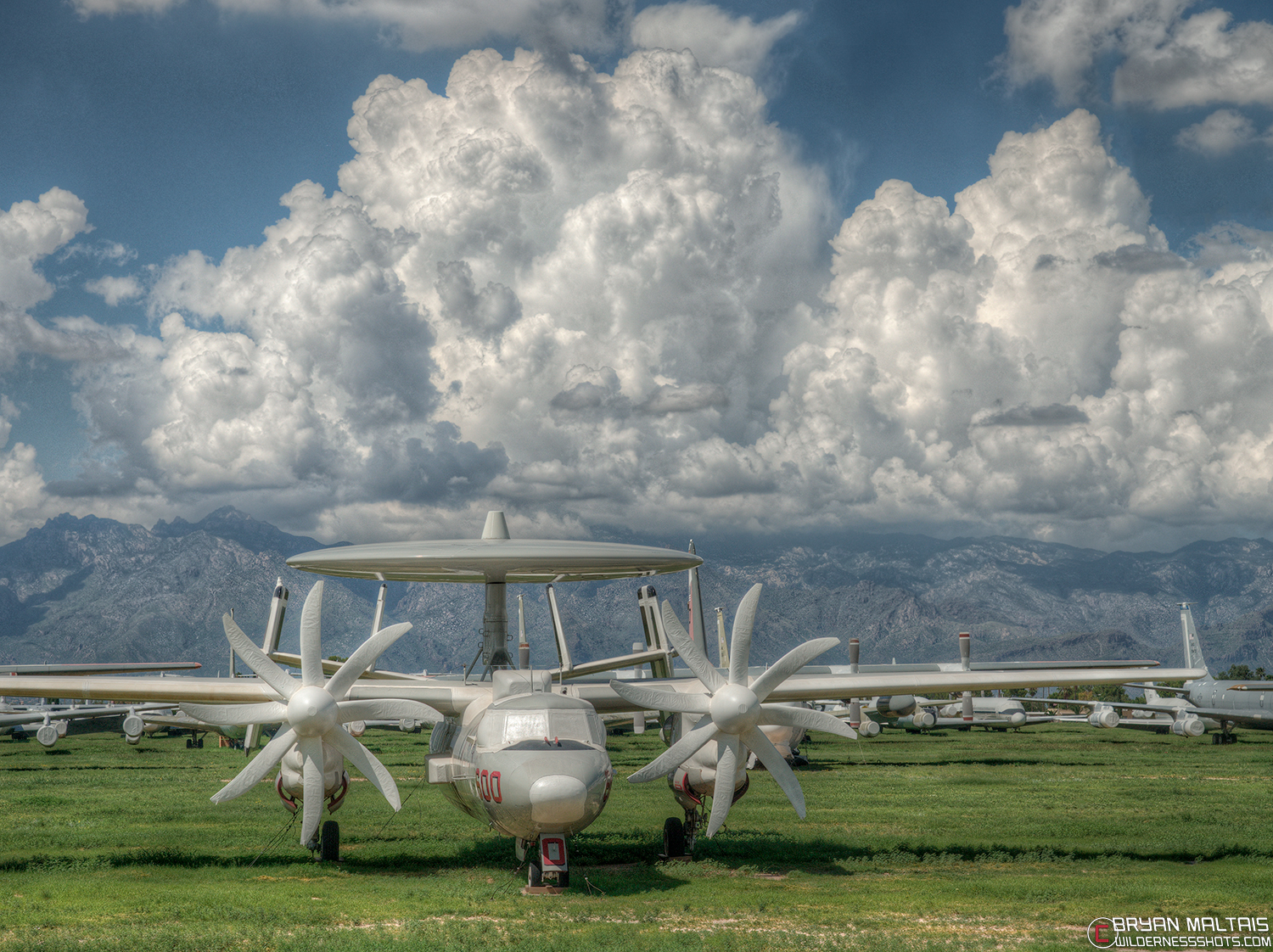
Aside from the spectacle of the boneyard itself, the area is very exciting for photographers. The background is filled with towering Sky Islands; mountain ranges that abruptly pierce the desert floor. Davis-Monthan is a busy Air Force base with combat aircraft and a flight training school. The airspace was growling with A-10 Thunderbolts, C-130 Hercules, UH-60 Blackhawks, and I even saw a pair of massive CH-53 Super Stallions, our biggest chopper.
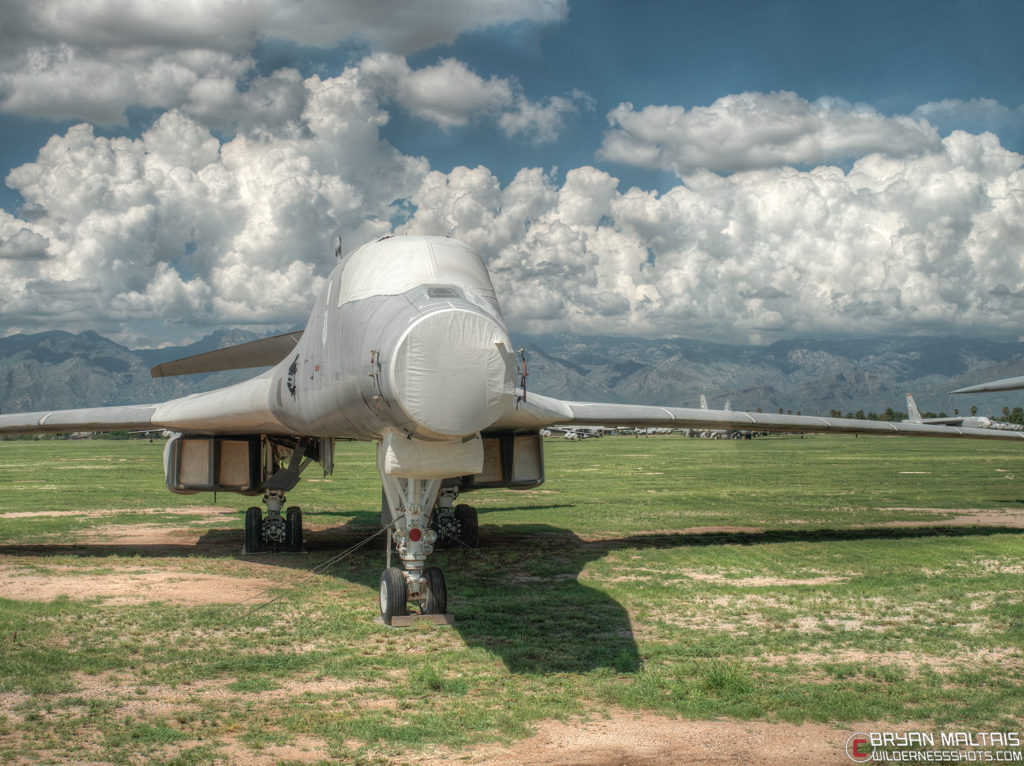
As a kid I was a huge military aviation buff and still am to a certain extent. My dad was a chopper pilot in the Army, which allowed him access to all US military bases. Growing up in Jersey, many of our vacations consisted of driving to the Air Force bases along the east coast where we’d go plane-spotting.
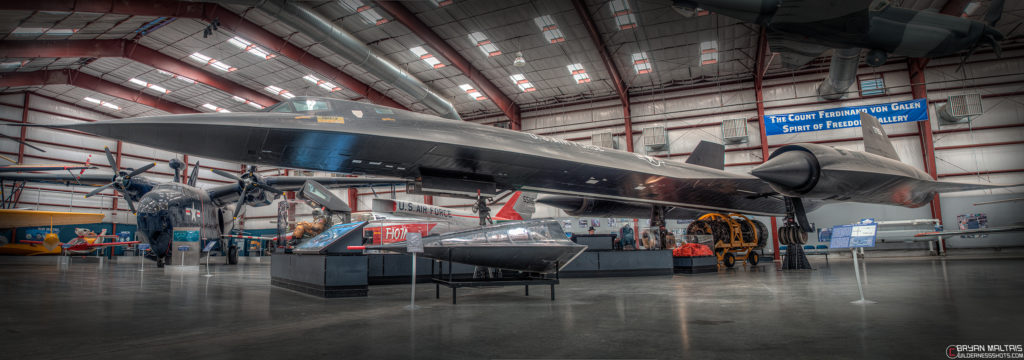
SR-71 Blackbird, Pima Aviation Museum
The boneyard contained almost every model of US military aircraft since the 70’s, but there were a few notable sights. It was incredible to see rows of the massive C-5 Galaxy, the free world’s largest ever airplane, parked dozens deep like toys. Once formidable B-1 supersonic tactical bombers laid defunct and torn apart.
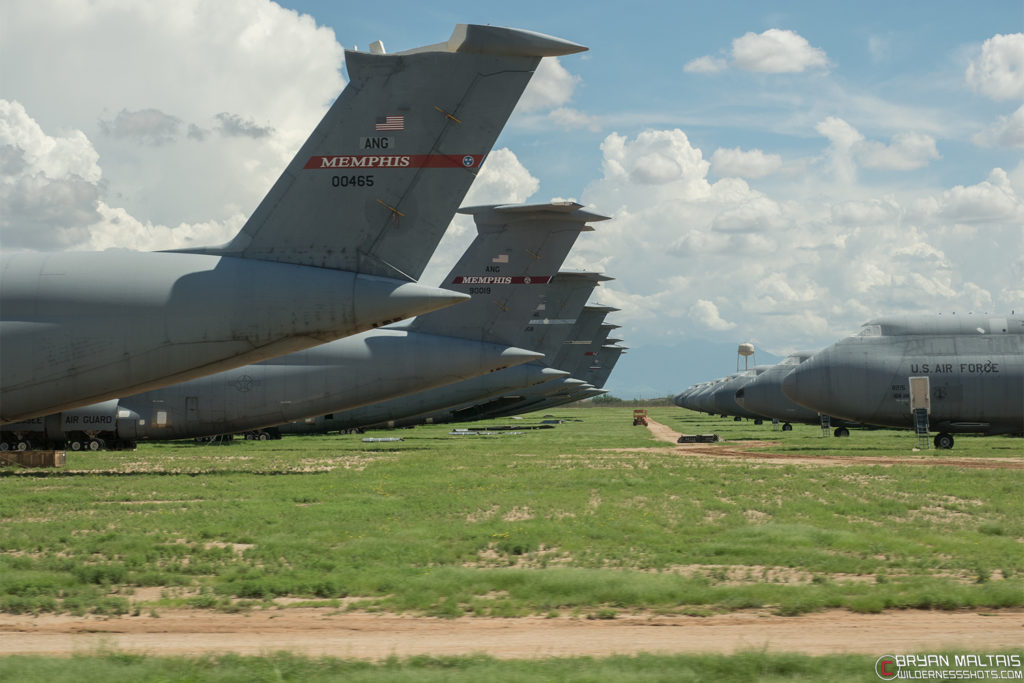
Rows of C-5 Galaxy’s at the Boneyard
What you need to know about photographing the Boneyard
The Boneyard is an active Air Force base. You’re not free to wander among the rows of aircraft; it can only be accessed by guided coach bus tour. The large, air-conditioned coach departs from the PIMA Aviation Museum and drives along the permitted roads within the boneyard. Since you’ll be photographing, you want to avoid getting stuck in an aisle seat. Make sure to get in line early to board the bus first to secure a window seat. I visited on a weekday and the bus was plenty full, so I’d probably avoid weekend crowds. You’ll be shooting through closed, tinted windows. To avoid reflections in the glass, hold your camera almost right against the window. I still had to do a lot of processing in a few of my photos to remove white reflections. During the first half of the tour, the bus stops briefly in front of each aircraft. During this period you’ll have enough time to concentrate on each shot. Here volunteer retirees, once themselves pilots, talk about each plane. During the second half of the tour the bus drives quickly up and down the rows without stopping. This will be run & gun photography with lots of panning. You get great views sitting on either side of the bus, but I’d probably recommend the right (passenger) side by a narrow margin as of Aug 2016. Having visited in mid August to purposely catch the Monsoon season, there were spectacular cumulonimbus clouds in the background.
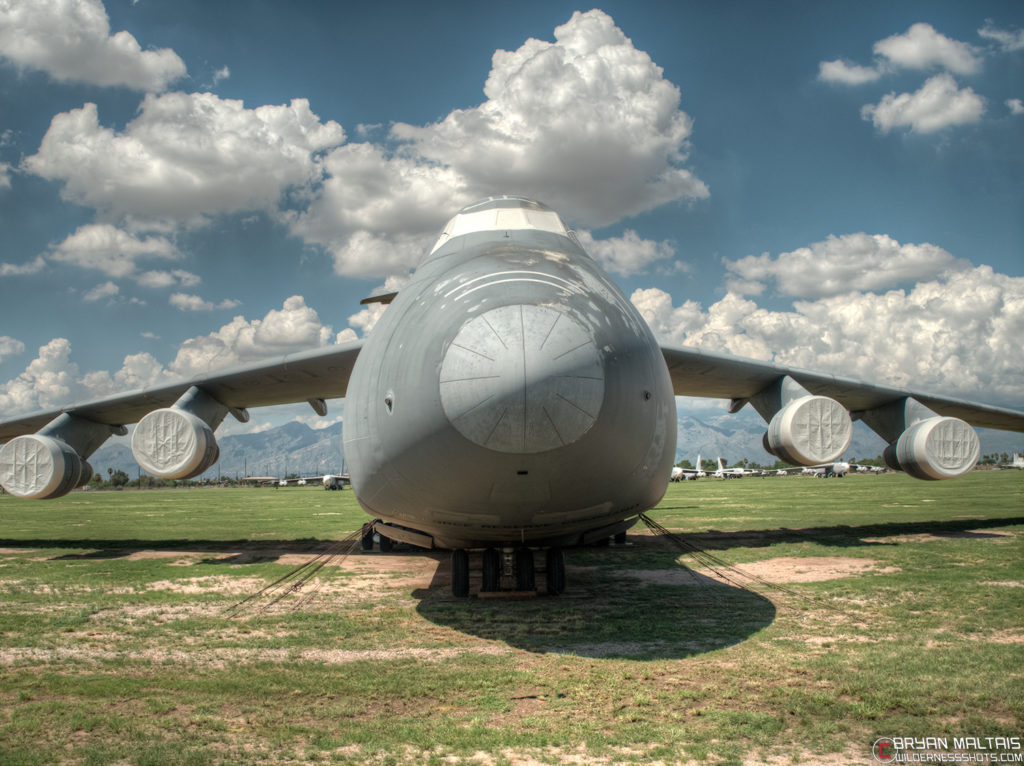
C-5 Galaxy, the free world’s largest Aircraft
As for the equipment that I used, the type of camera for this basic type of photography is irrelevant, but the lens is important. It’s best to have a zoom lens that goes from very wide to medium telephoto. You’ll use wide angle for when your bus parks right in front of the nose of a C-5 Galaxy, and telephoto to shoot way down the rows of aircraft. Though blue skies may tempt one to use a polarizer, I didn’t want to rob myself of two stops and add yet more glass, while already shooting through tinted windows.
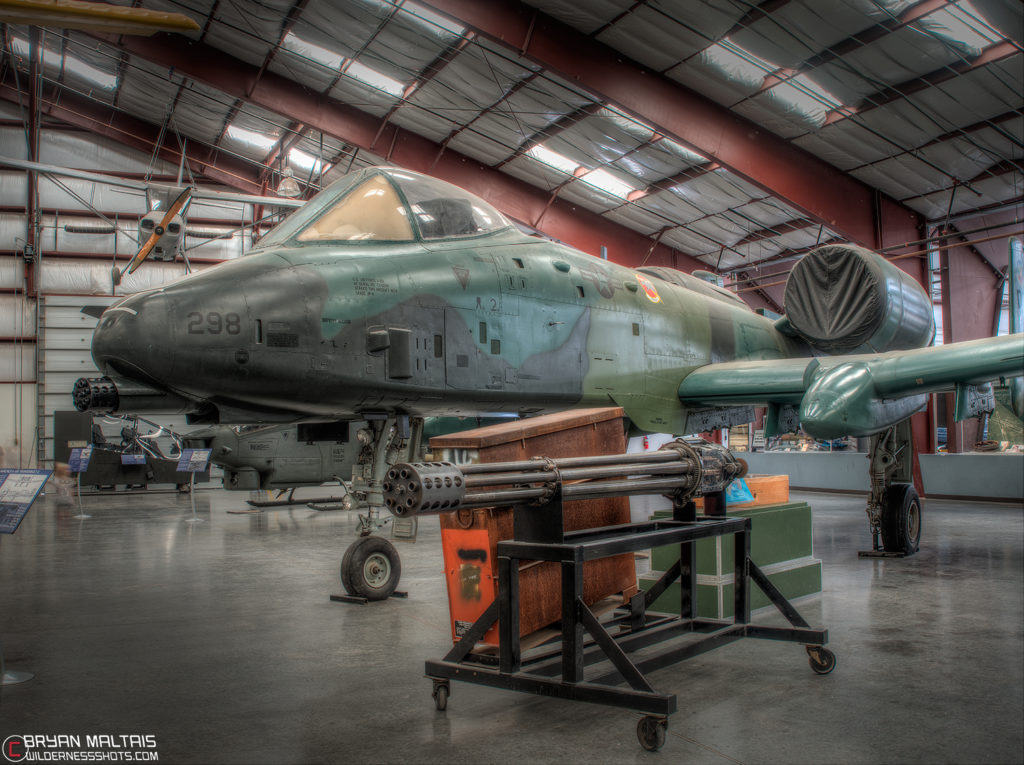
A-10 Thunderbolt, Pima Aviation Museum
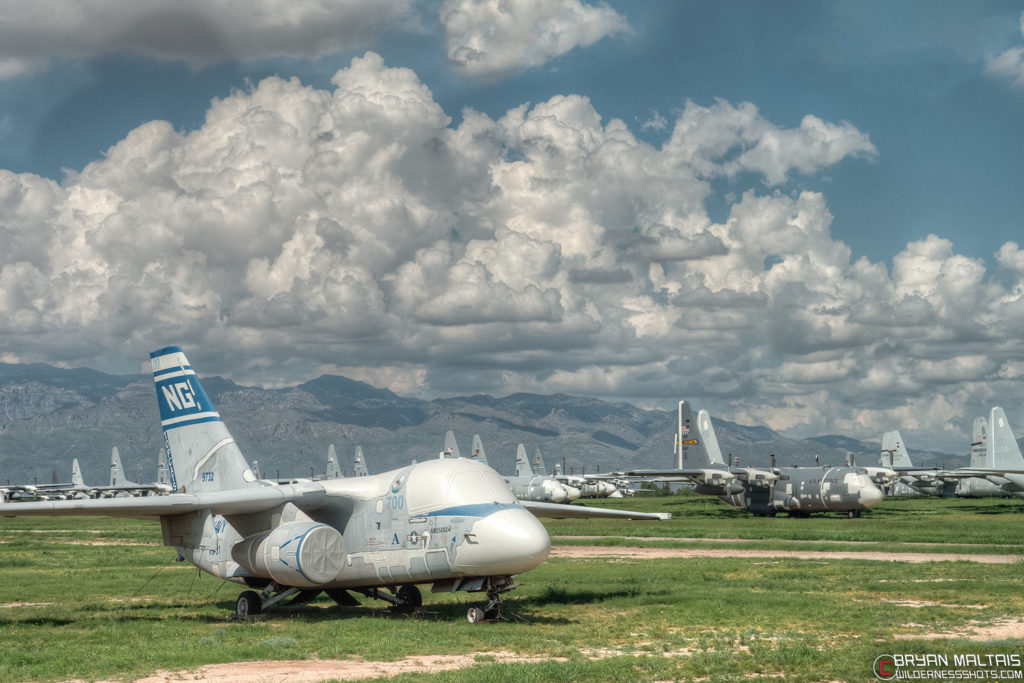
S-3 Viking, Boneyard
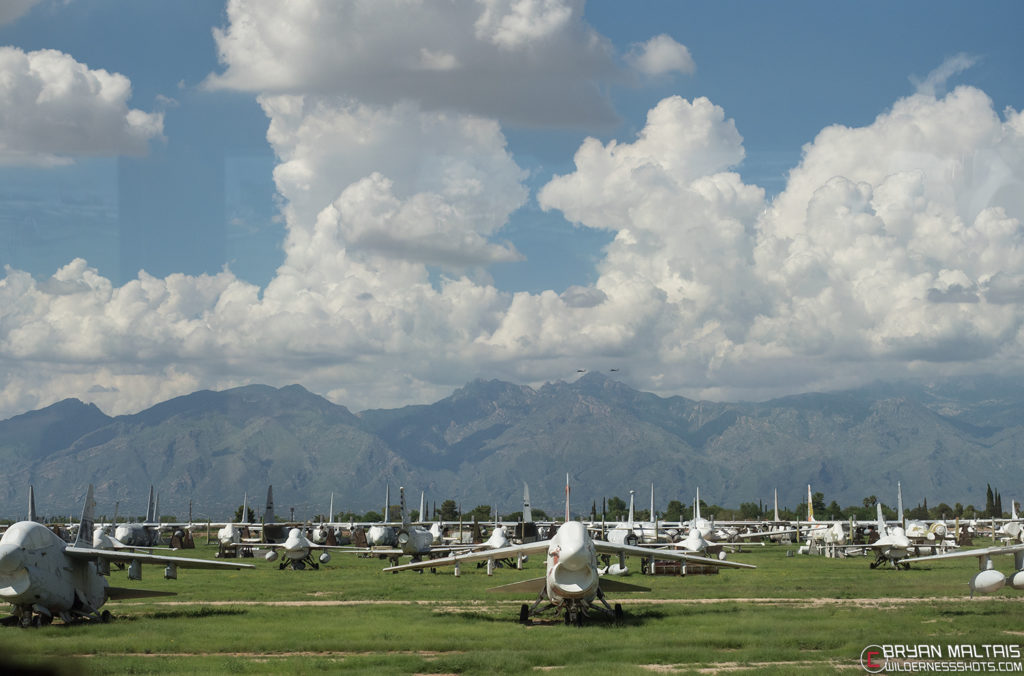
Share this:
Upcoming photo workshops.
- Macro Photography-Missouri Ozarks. Apr 27-29, 2024
- Colorado Fall Colors. Sept 29-Oct 2 and Oct 3-6, 2024
- Bisti Badlands. Oct 10-13, 2024
- Bosque del Apache. Dec 11-14, 2024
Registration and Info here
- How to use the Hyperfocal Distance in Landscape Photography
- How to Photograph Star Trails-Easy Instructions for Beginners
- How to use Light Metering Modes and Exposure Compensation in Photography
- What’s the difference between Lightroom and Photoshop?
- How to Cull Photos in Lightroom
One Comment
The bus tour is no longer running.
Leave a comment or question Cancel reply
© 2008-2024 Wilderness Shots/Bryan Maltais. Nature Photography Workshops and Colorado Photo Prints
- Nature Photography Workshops
- RMNP Private Photo Tours
- Private Workshops
- Fort Collins Photography Lessons
- Gift Certificates
- San Juan Mountains
- Crested Butte
- Rocky Mountain National Park
- Sonora Desert
- Northern Arizona
- New Zealand
- Macro Photography
- Reptiles & Amphibians
- Panoramic Prints
- Into the Forest
- Der Magische Wald
- Metamorphosis

Qatar Airways and China Southern Airlines sign new codeshare agreement


In pictures: Dublin Airport reveals plans for new dedicated plane spotting hub

Russian military aircraft suspected of violating Finnish airspace

Archer’s Midnight eVTOL aircraft completes first-ever transition flight: video
- ZeroAvia hydrogen-powered aircraft
- zero-emissions
- Zero emission
- Yeti Airlines
- Aviation Top 10s
Biggest aircraft boneyards in the world
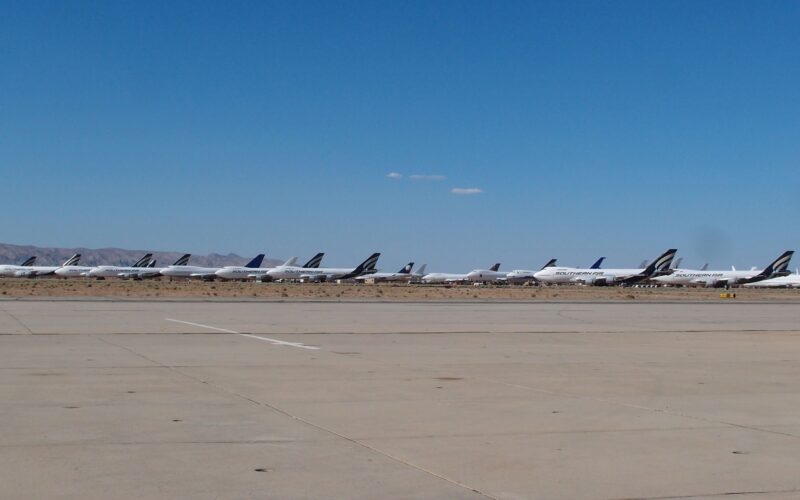
Any aircraft, whether it is a commercial airliner or military cargo plane has a limited lifespan. The retirement of the civil aircraft usually turns into a celebration before their final flight. The airlines often put their final aircraft on a tour around the country or initiate the farewell international flight. It gives people the final opportunity to see the iconic aircraft in its authentic airline colors. But when the old machine’s engines stop and cool down for the last time, what happens next?
There are two ways of how airlines utilize retired planes. In case of a positive outcome, the old plane is put into the open air aviation museum, like the famous Concorde or Tupolev Tu-144. However, most of the retired planes spend their last days in so-called boneyards or graveyards.
The purpose of the aircraft boneyards and their location
An aircraft graveyard or boneyard is the place where planes go to rest after their service comes to an end. Sometimes the retired machines can get a second life under another airline name. However, most of the aircraft spend their last days in graveyards forever. The majority of the aircraft boneyards are used to store retired airplanes before their parts are removed for reuse or resale. Usually the disassembled airplanes are scrapped after such a procedure. The retired planes are crashed with excavators that can demolish a small plane like Boeing 737 in a couple of days. The bigger models might need a month of work.
Most of the graveyards are located in deserts, far outside people’s settlements. Dry air conditions and baking sun help to hold the corrosion of planes and the hard ground does not need to be paved. Most of the graveyards are closed for visitors and do not provide any tours.
Most of the biggest aircraft boneyards are found in the United States. There might be a few reasons why. First of all, even retired planes require a lot of work, time and, what is more crucial, space. There are acres of free open space in the south-western U.S. This region, with its dry climate, low humidity, and little rain, provides the perfect conditions for the old planes’ storage.
1. Davis-Monthan located nearby the Arizona city of Tucson.
This graveyard stores around 4,400 aircraft, arranged over nearly 2,600 acres (10.5 sq km). The facility workers call it simply Boneyard. The location is run by the 309th Aerospace Maintenance and Regeneration Group (309 AMARG). The graveyard gave shelter to different kinds of airplanes, including broken or retired B-52 bombers, B-29 Superfortresses, C-47 Skytrains, United Airlines Boeing 727-100, and many more. The majority of the preserved aircraft in the Davis-Monthan belongs to military aviation. The facility has controlled access, not permitted for visitors. The only access to the boneyard is via a bus tour. The tour begins nearby Pima Air and Space Museum and lasts about an hour. The bus stops at different locations of the Davis-Monthan, but no one is allowed off the bus.
2. S outhern California Logistics Airport / Victorville (VCV)
The boneyard is located in the city of Victorville in San Bernardino County, in the Mojave Desert. A warm and dry climate here made it the perfect place to keep aging airplanes for extended periods. The airport’s longest runway is more than 15,000 feet long, capable of handling fully loaded 747s.
The Victorville graveyard is currently storing around 275 passenger and cargo aircraft. Numerous large ex-Orient Thai and British Airways Boeing 747, Singapore Airlines ( SIA1 ) ( SINGY ) , Air New Zealand, and Cathay Pacific planes, older McDonnell Douglas DC/MD-10 and MD-11 freighters, Lockheed, and Airbus aircraft owned by major airlines are currently kept at Victorville.
3. Phoenix Goodyear Airport (GYR)
Following the end of World War II, the primary role of the GYR was to store and preserve U.S. Navy, U.S. Marine Corps, and U.S. Coast Guard aircraft. At some point, the facility stored more than 5,000 aircraft. By early 1958, the numbers decreased to 2,500 aircraft.
After the closure of NAS Litchfield Park in 1967, the City of Phoenix purchased the airport for a general aviation facility. Today, the airport offers aircraft maintenance, pilot training and stores such commercial planes like Boeing 737, Airbus A340 and Boeing 747s.
4. Tarmac aircraft boneyard, Teruel Airport, Spain
The Teruel Airport is located about 100 miles south of Zaragoza, Eastern Spain. Its location 1,000 meters above sea level and a cold, dry plain climate provide perfect conditions for the retired passenger airliners storage.
It was initially constructed to house commercial aircraft, including Boeing, Airbus, and Bombardier. Opened in 2013, the facility nowadays offers long-term aircraft parking, recycling, aircraft painting, aircraft assembly, and fitting-out services.
It is the biggest aircraft boneyard in Europe, designed to handle 250 large planes. After the air travel was put on hold due to the coronavirus pandemic, different European carriers, including British Airways, sent some of their Boeing 747s to Teruel for storage.
5. Khodynka Field, Domodedovo Airport, Russia
Initially built to service commercial flights, the airfield became one of the most popular aircraft boneyards in Russia. The last plane took off from here in 2003. Nowadays part of the aircraft has been scrapped. The machines that were better preserved are now in the Vadim Zadorozhny Museum of Technology. The vast territory of the aircraft boneyard on the Khodynka field is surrounded by barbed wire and guarded.
Sign Up for Our Newsletters
Related posts.
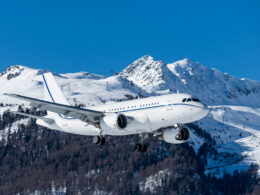
The Top 10 largest private jets in the world in 2024
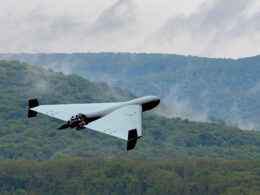
Top 10 world’s best military drones in 2024 and their capabilities
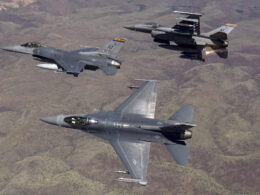
Top 10 most widely operated fighter jets in 2024

The Top 10 longest non-stop flights in the world in 2024

AeroTime is on YouTube
Subscribe to the AeroTime Hub channel for exclusive video content.

Stories from Southeastern Arizona, by students at the University of Arizona School of Journalism
Davis-Monthan and the role of the ‘Boneyard’
The massive tails of retired and stored military aircraft peeping over the top of Kolb Road’s steeped walls is a familiar sight for most people in Tucson. But most people don’t know about the many functions of the so-called Boneyard beyond that of a cemetery for airplanes that are no longer in use.

Formally known as the 309th Aerospace Maintenance and Regeneration Group, or AMARG, the Boneyard is a specialized facility within the Air Force whose official mission is to “provide aerospace maintenance and asset regeneration to our customer for the sustainment of the warfighter.” On the vast desert aprons of the Boneyard are more than 4,400 aircraft of all types once flown by the Air Force, the Navy and Marine Corps and the Army, as well as the Coast Guard.
“We don’t mind the term ‘Boneyard’, but it’s a misnomer,” said the commander of the 309th AMARG, Col. Robert Lepper. “We’re known around the world as the Boneyard. So we love the term. But it gives people an impression that this is where planes come to die.”
In fact, aircraft disposal is only one of five of AMARG’s missions, which means that 80 percent of the Boneyard’s functions do not include chopping up planes for scrap. The five main missions of AMARG are storage and preservation, reclamation, regeneration, depot-level overflow and finally, disposal.
The Boneyard just celebrated its 68th birthday, on April 1. Older than the United States Air Force itself, the Boneyard was originally a storage facility created in the wake of World War II, specifically for B-29 and C-47 aircraft, according to the Davis Monthan AFB website .
There are more than 4,000 planes at the Boneyard requiring a large area of land where aircraft can be preserved or stored: 2,600 acres to be exact. Tucson was specifically chosen for the location of the Boneyard for a few reasons: low humidity, low rainfall and very, very hard ground. The desert’s caliche is a thick layer of highly compacted, dry dirt that provides AMARG a place to park planes without having to pave a massive area of land, and without fears of the plane literally sinking into the ground.

When planes are sent to the Boneyard to be put in storage, they’re stripped of their engines and fluids, sealed with a multi-step latex spray covering and are destined to wait under the desert sun until they are needed again. Aircraft from the Air Force, Navy, NASA, and even foreign allied forces are kept in storage at AMARG.
“Every four years, those airplanes come back to life to keep the assets in good shape,” said Tye Lockard, deputy director at the 309th AMARG.
Last October, because of the congressional sequestration cuts in military funding, the Air Force decided not to put the brand new C-27J planes into use, according to Lepper. They were sent straight into storage.
“People think that everything that comes in here comes to be destroyed. That’s not true,” Lepper said. “There were a lot of people that were very unhappy because many of those planes came straight off the production floor and came straight here.”
The United States Special Operations Command is getting seven of the planes and the U.S. Coast Guard is getting 14 of them. But they still aren’t ready to accept them. The new homes for the Spartans don’t have the technicians, the pilots or the equipment for the planes. Within the next six months to a year, the C-27Js are expected to move from the Boneyard to their new locations.
“We knew they’d be used, and now we know who’s going to be getting them,” Lepper said.
AMARG returns a half a billion dollars worth of assets and parts back into service every year, according to Lepper.
“Each time we pull a part, it goes to support another aviation asset either for the United States or one of our allies for an aircraft that’s grounded,” he said. “Every day we keep airplanes flying for the United States and our allies around the world.”
Parts can be used by U.S. allies, government agencies and all of the military branches.
“Every part that we regenerate or reclaim is a saving for the taxpayers,” said Lockard.
Every year, the Boneyard regenerates 60 to 100 planes that have been in desert storage for different lengths of time and makes them flyable.
Last month, AMARG regenerated the last F-4 that had spent 24 years in desert storage.
“I bet your parents don’t own a car for 24 years, let alone own it, drive it it’s full service life, park it for 24 years, and then make it drive again. Most people can’t dream about that with a car, and we did it with an airplane,” Lepper said.

Taking a plane from storage and making it flyable again is a hugely complex process, but one that keeps military aircraft in the air for longer than their lifespans.
“Really the epitome of AMARG is the sign of the phoenix,” Lockard said. “It is really literally taking those aspects of ashes and regenerating them into flight again.”
In the F-16 Regeneration Hangar at the Boneyard, technicians are working to make the F-16s flyable again so they can be transferred to Tyndall AFB in Florida, where Boeing will install a package that will make the airplane unmanned. The planes will then be used as full-scale aerial targets for Air Force training purposes.
There are only three major depots in the Air Force. The depots are designed to take aircraft completely apart, look for cracks and faults, make sure everything is good, and put them back together. AMARG supports depot-level overflow work. Additionally, AMARG is the only location work on A-10 modifications on the Desert Speed Line, according to Lepper.

“We’re taking every A-10 in the United States A.F. inventory and installing two major modifications,” Lepper said, “further enhancing the A-10 which is a phenomenal airplane all-around.”
The Helmet Mounted Queuing System modifications for the A-10s will give pilots a sort of monocle that will allow them to turn his head while still being able to see valuable information. Another modification will help the A-10 more effectively locate and rescue downed pilots.
There is some truth to the Boneyard being an airplane cemetery. About 200 t0 300 planes every year are scrapped and disposed of by the Defensive Logistics Agency as part of a positive financial business.
“We don’t dispose of them until everyone in the federal government says they don’t need them,” said Lepper.

But is the Boneyard a junkyard? Pieces of the aircraft are boxed in custom wood containers, engines are preserved in metal barrels with nitrogen, and parts are negatively inventoried so that personnel can know exactly how many of one specific part are still on the planes at AMARG. Additionally, AMARG aims to keep the environmental impact of storing planes in the desert to a minimum.
“There’s always a Hazmat requirement for disposal to make sure that we don’t contaminate the environment,” said Lockard. “We purge the airplanes of all chemicals as much as is feasible minimizing environmental impact.”
Lockard added that there are some environmental risks associated with old airplanes, including asbestos, but each aircraft is subjected to E.P.A. environmental rules and regulations.
Boneyard Tours
Visitors are welcome to tour the Boneyard in partnership with the Pima Air and Space Museum, which is the largest privately funded, non-governmental aerospace museum in the country.

“People don’t understand what’s in their own backyard. It’s amazing,” said Lepper. “It’s like if you lived up near the Grand Canyon and never visited, shame on you. Come visit us if you live in Tucson.”
The tour, given in an air-conditioned bus, allows patrons and tourists to escape the desert heat while being educated about the missions of AMARG and some of the types of planes stored in the Boneyard. The bus even takes a trip down “Celebrity Row,” a strip of dirt road lined on either side by a display of various types of planes, including a C-130 Hercules that is the only aircraft to have ever been awarded an honorary Purple Heart for its service in the Vietnam War.
“We are not a museum. However, there is a tremendous amount of history that has passed through or is currently here,” said Lepper.
What’s the future for the Boneyard?
In an interview with Mayor Jonathan Rothschild , the Tucson mayor addressed questions about the future of Davis- Monthan Air Force Base. He acknowledged discussions of possible reductions or even a closing of the base at some point in the future, but said that he doubted it would close, specifically because of certain unique operations in Tucson, the Boneyard being a major factor. He also discussed the possibility of losing the A-10s and the need to evaluate diversification at Davis-Monthan, including into aerospace and other jobs-producing areas.
But what would a potential reduction of base operations caused by eliminating the A-10 mean for the Boneyard?
“If the Air Force draws down a lot, the question is if the Boneyard can handle a huge influx of planes if the government decides to get rid of the A-10s, and things like that,” said Lepper.
Leave a Reply Cancel reply
Your email address will not be published. Required fields are marked *
Save my name, email, and website in this browser for the next time I comment.

Davis-Monthan AFB AMARG: The Vide
Davis-Monthan Air FOrce Base is the location of the 309th Aerospace Maintenance and Regeneration Group (AMARG) , the sole aircraft boneyard and parts reclamation facility for all excess military and government aircraft.
Aircraft from the Air Force, Navy, Marine Corps, Coast Guard, NASA and other government agencies are processed at AMARG, which employs 550 people, almost all civilians. It is the largest airplane boneyard in the world.
This video highlights storage and parts reclamation activities at AMARG. It runs fairly quickly, so sit back and enjoy ... and turn up your volume for some easy-listening music!
Like all YouTube videos, you can click to view full screen, and mute the music if you like.
YouTube Video of Davis-Monthan AFB AMARG boneyard in Tucson, Arizona
SITE MAP | PRIVACY POLICY | TERMS OF USE | CONTACT US
Copyright © 2024 AirplaneBoneyards.com All Rights Reserved. An online resource about facilities engaged in the storage, reclamation & disassembly of aircraft ... we do not own or operate a boneyard, or have an affiliation with any boneyard, the Department of Defense, or any aviation museum or tour group.
Everything You Need to Know About the Military Boneyards Where U.S. Aircraft Await Their Next Act
Warplanes can last for decades, and then remain structurally viable for several decades more—meaning military boneyards are like a purgatory for fighters, bombers, and transports.

- While the Pentagon maintains the world’s largest boneyard, the concept is relatively unknown to other countries.
- Most countries fly planes until they are no longer useful, but America’s four air forces retire planes that are still useful all the time.
The “boneyard” is a macabre term that has come to stand for places—that are usually dry and dusty—where airplanes are sent to wait. Sometimes, the planes are waiting to fly again; sometimes the planes are waiting to go to the scrapyard. But by and large, the military aircraft boneyard is an American phenomenon, in which a combination of geography and the world’s largest air force creates a stable supply of planes that the U.S. government isn’t quite sure what to do with. Here’s everything you need to know about them.
End of Life

Military aircraft have varying lifespans. In wartime, the life of a fighter, bomber, or transport plane could be measured in minutes, as attrition grinds down a fighting air force. Warplanes have always been semi-disposable assets in wartime; until as recently as Vietnam, air armies have fully expected to lose planes in combat.
Peacetime is a different story. The use of steel and aluminum over wood and fabric dramatically increased the service life of warplanes, to the point that almost all eventually become technologically obsolete long before they become worn out by the stresses of flight operations. The average U.S. Air Force aircraft is about 30 years old , and the service must contend with eight fleets over the age of 50.
All of this means that warplanes can last for decades, and then remain structurally viable for several decades more. Entire fleets of airplanes have received mid-life updates designed to increase their service lives: the F/A-18E/F Super Hornet is receiving the vital Block III upgrade , the A-10 Warthog fleet received new wings , and the F-16 Fighting Falcon is in the process of getting a radar makeover . The potential for upgrades, combined with plane fleets that keep flying for decades or more, make it worthwhile to keep old planes around …for a little while, anyway.
Rich Country Problems

The U.S. military, including the Air Force, Navy, Marine Corps, and Army, currently operates about 13,000 aircraft of all types. This runs a broad gamut from fighter jets like the F-22 Raptor and F-35 Lightning II to planes like the C-17 transport and Guardrail intelligence-gathering aircraft. The worldwide fleet is adding and subtracting planes every day. Some aircraft are cut because they are worn out, others succumb to budget cuts. All are still useful as scrap, but many are a little more useful than that, ranging from still being flyable to having useful parts, such as ejection seats, that can still be harvested from an unflyable plane.
Since World War II , the U.S. military has used the southwestern desert to keep planes in a post-retirement holding pattern. At Davis-Monthan Air Force Base in Arizona, thousands of aircraft sit awaiting their eventual fate. The lack of rainfall and humidity slows their deterioration in the outdoors, making recovering parts and equipment decades after retirement a viable proposition. Some planes eventually re-enter service: in 2021 the B-52H bomber “Wise Guy” rejoined America’s bomber fleet after a lengthy refurbishment, though it may have had a scorpion or two hiding in the wheel wells.
The bottom line is, the United States is a rich enough country to avoid cutting up planes for scrap value as soon as they leave service, wisely keeping them around just in case.
The Rest of the World

Other countries, even NATO allies, have relatively few aircraft and retire planes in much smaller numbers. The United Kingdom, for example, has only 142 fighter jets , while France has 266, and Germany has 209. These fleets are relatively small, grow slowly, and planes are retired infrequently. These countries also lack the arid conditions to store jets in good condition. In Europe, the closest thing to a boneyard is the private fighter jet collection of vintner Michel Pont .
Russia has the capacity to store warbirds, but most of the fleet was likely cut up for scrap during the 1990s and 2000s. One location with military aircraft is the Central Aviation Museum outside of Moscow. Aside from the usual Mikoyan-Gurevich and Sukhoi jets, the museum hosts a Tu-22 “Backfire” bomber, Mi-26 “Halo” heavy lift helicopters, a Mil V-12 twin-rotor superheavy helicopter , Yak-28 “Brewer” attack jets , and at least one intact Yak-38 “Forger” vertical takeoff and landing fighter . Zhukovsky International Airport is another location with a mix of well-known and not-so-well-known aircraft, including the experimental Sukhoi Su-47 Berkut (“Golden Eagle”) swept-wing fighter and the MiG 1.44 prototype fighter .
China’s air forces, the People’s Liberation Army Air Force and People’s Liberation Army Navy Air Force, have undergone rapid expansion over the past two decades. China is known to have held onto large numbers of J-6 fighters, and there are suggestions the planes are being modified to act as unmanned aerial vehicles . There is the China Aviation Museum north of Beijing with a modest collection of 20th-century Chinese warplanes. China does not appear to have an official boneyard of Chinese air power, but if it exists it is probably in the hot, dry, Xinjiang province.

Kyle Mizokami is a writer on defense and security issues and has been at Popular Mechanics since 2015. If it involves explosions or projectiles, he's generally in favor of it. Kyle’s articles have appeared at The Daily Beast, U.S. Naval Institute News, The Diplomat, Foreign Policy, Combat Aircraft Monthly, VICE News , and others. He lives in San Francisco.

.css-cuqpxl:before{padding-right:0.3125rem;content:'//';display:inline;} Pop Mech Pro: Military .css-xtujxj:before{padding-left:0.3125rem;content:'//';display:inline;}

What We Know About Russia’s Mystery Radio Signal

Can the Army’s New Rifle Take on Russian Armor?

Inside the CIA’s Quest to Steal a Soviet Sub

The U.S. Has Built an Unstoppable Microwave Weapon

China Could Rule the Seas With This New Tech

This Is the Most Lethal Submarine in the Sea

The Most Expensive Plane Crash in History

Can America’s Aging F-16 Overpower Russia’s Su-35?

Get to Know the Marines’ Favorite Ride

Meet the Navy’s New Radar-Killing Missile

Could the U.S. Army Fight and Win Without Tanks?

Davis-Monthan announces passing of legendary pilot
TUCSON, Ariz. (13 News) - Officials at Davis-Monthan Air Force Base announced the passing of a legendary pilot.
Davis-Monthan says U.S. Air Force Brig. Gen. (retired) Clarence E. “Bud” Anderson, the last surviving triple ace pilot from World War II, passed away peacefully May 17, 2024 at the age of 102.
A flying ace is an aviator credited with downing five or more enemy planes.
Davis-Monthan says Bud was decorated three times over, awarding him with the World War II triple ace. He flew over 130 different types of aircraft during more than 7,500 flight hours throughout his military career and into retirement.
Born Jan. 13, 1922, Bud earned his pilot’s license as a teenager and enlisted in the Army Air Forces at age 19, six weeks after the Japanese attack on Pearl Harbor. Upon completing training, he arrived in Europe in 1943 and became one of the first pilots to fly the P-51 Mustang with the 357th Fighter Group.
While piloting the many P-51 Mustang aircraft variants over the Western front, Bud brought down 16 German aircraft and shared the credit on a 17th across 116 missions and more than 480 combat hours.
“On the ground, he was the nicest person you’d ever know,” Brig. Gen. Chuck Yeager wrote in an autobiography. “But in the sky, those Germans must’ve thought they were up against Frankenstein or the Wolfman; Andy would hammer them into the ground, dive with them into the grave, if necessary, to destroy them.”
At the conclusion of World War II, Bud went on to command the 69th Fighter-Bomber Squadron in Osan Air Base, Korea, during the Korean War and the 355th Tactical Fighter Wing at Takhli Royal Thai Air Force Base during the Vietnam War. Eventually overseeing the wing and base inactivation Dec. 10, 1970.
The 355th Wing was reactivated in 1971 along with the 357th Fighter Generation Squadron at Davis-Monthan AFB, Ariz.
“Brig. Gen. Anderson’s leadership and command of the 355th Tactical Fighter Wing was instrumental in our nation’s past conflicts,” said U.S. Air Force Col. Scott Mills, 355th Wing commander. “Today the 355th Wing remembers and honors both the individual and his service to the nation.”
Bud also played a pivotal role as a fighter test pilot once he was back stateside serving at Wright-Patterson AFB, Ohio. He retired from the Air Force in 1971 to manage a test facility at Edwards AFB, Cali. He left with the rank of colonel and received an honorary promotion to the rank of brigadier general in 2022.
Be sure to subscribe to the 13 News YouTube channel: www.youtube.com/@13newskold


IMAGES
VIDEO
COMMENTS
The Davis-Monthan Air Force Base is one of a kind and certainly a wonder to behold. It is a US Air Force base 5 miles southeast of downtown Tucson, Arizona, and is famous for its massive aircraft boneyard for storing American military aircraft. The Davis-Monthan Air Force Base is the destination for all American excess military and aerospace craft.
Airplane boneyards, Davis-Monthan AFB AMARG military aircraft boneyard, airliner boneyards, airplane disposal after World War II, maps, photographs, tours, and locations. ... the U.S. military had a huge surplus of aircraft. By the summer of 1945, sales-storage depots, or "aircraft boneyards", were in operation to deal with nearly 120,000 ...
Due to changes in U.S. Air Force security considerations, the offsite bus tours of the 309th AMARG (AKA "The Boneyard") are no longer available, with no plans to restart. However, the Pima Air & Space Museum will provide an opportunity to learn about the history of AMARG and have a very similar experience viewing rare aircraft outdoors in a desert climate while immersing yourself in ...
Davis-Monthan Air Force Base's role in the storage of military aircraft began after World War II, and continues today. It has evolved into "the largest aircraft boneyard in the world".With the area's low humidity in the 10%-20% range, meager rainfall of 11" annually, hard alkaline soil, and high altitude of 2,550 feet allowing the aircraft to be naturally preserved for cannibalization or ...
Please note: This tour is located on the grounds of Pima Air and Space Museum and will not include the AMARG (AKA the Boneyard) located on Davis Monthan Airforce Base. We can not accommodate any request for private tours of the AMARG facility. Private trams are available for groups booking within two weeks of their visit date.
A Tour of the Boneyard. The aircraft retirement home in Arizona is well worth a visit. ... Pima is adjacent to the fence line of Davis-Monthan AFB, home of the "Boneyard." Its official name is ...
The 309th Aerospace Maintenance and Regeneration Group (309th AMARG), [2] often called The Boneyard, is a United States Air Force aircraft and missile storage and maintenance facility in Tucson, Arizona, located on Davis-Monthan Air Force Base. The 309th AMARG was previously Aerospace Maintenance and Regeneration Center, and the Military ...
The Aerospace Maintenance and Regeneration Group (AMARG) aka "The Boneyard" is located at Davis-Monthan AFB in Tucson, AZ. The Boneyard is an open-air, desert storage facility for retired military aircraft. Many of these aircraft are in a state of preservation and, therefore, available to be called back into service if needed. Certain airframes ...
Arizona's Davis-Monthan Air Force Base - colloquially known simply as The Boneyard - takes the title of world's largest, with upwards of 4400 decommissioned military and space aircraft parked in highly organised rows across its 10.5-square-kilometre space just outside Tucson. ... the 309th Aerospace Maintenance and Regeneration Group (AMARG ...
Air Force "Boneyard". This is an excerpt from the Airplaneboneyards.com website. Davis-Monthan AFB's role in the storage of military aircraft began after World War II, and continues today. It has evolved into " the largest aircraft boneyard in the world ". With the area's low humidity in the 10%-20% range, meager rainfall of 11 ...
The tour is limited to 3 hours due to hot weather conditions. Boneyard Safari is located at 10645 N Oracle Road, Suite 121 - 101, Oro Valley, Arizona 85737. Phone 520.314.7478. For more information: Aircraft Restoration & Marketing (ARM) Boneyard Safari. Tours offer walk through aircraft, history at Tucson "boneyard"
Durand Silva, an aircraft maintainer with the Civil Service, sprays down the tail of a C-130 being prepared to be sent off from Davis-Monthan Air Force Base's Aircraft Boneyard to a new customer ...
PART ONE | This series of three videos will take you around the Davis-Monthan Air Force Base in Tucson Arizona, which is the world larges Aircraft Boneyard. ...
Boneyard Safari Docents will guide 10 guests through a C-130, DC-3/C-47, Boeing 727, and walk around various other aircraft including a C-27A, T-37, C-131F, and P-3. It is limited to 3 hours due to weather conditions. Bring your cameras because this is a unique opportunity to go inside of aircraft as they are being regenerated or seeing their ...
Aside from the spectacle of the boneyard itself, the area is very exciting for photographers. The background is filled with towering Sky Islands; mountain ranges that abruptly pierce the desert floor. Davis-Monthan is a busy Air Force base with combat aircraft and a flight training school. The airspace was growling with A-10 Thunderbolts, C-130 ...
The majority of the preserved aircraft in the Davis-Monthan belongs to military aviation. The facility has controlled access, not permitted for visitors. The only access to the boneyard is via a bus tour. The tour begins nearby Pima Air and Space Museum and lasts about an hour. The bus stops at different locations of the Davis-Monthan, but no ...
Another Boneyard Tour...this time there are 4000 military aircraft to view. We took the bus tour to the "Boneyard" at the Davis-Monthan Air Force Base. Thi...
The Boneyard just celebrated its 68th birthday, on April 1. Older than the United States Air Force itself, the Boneyard was originally a storage facility created in the wake of World War II, specifically for B-29 and C-47 aircraft, according to the Davis Monthan AFB website.
Davis-Monthan AFB AMARG: The Vide. Davis-Monthan Air FOrce Base is the location of the 309th Aerospace Maintenance and Regeneration Group (AMARG), the sole aircraft boneyard and parts reclamation facility for all excess military and government aircraft.. Aircraft from the Air Force, Navy, Marine Corps, Coast Guard, NASA and other government agencies are processed at AMARG, which employs 550 ...
The 2,600-acre area, officially called the 309th Aerospace Maintenance and Regeneration Group (AMARG) though popularly known as "the Boneyard," is filled with retired aircraft, including ...
Delta, the world's second largest airline, sent its final 747 to an Arizona "boneyard" this week, marking another chapter in the slow death of the jumbo jet. Last month United, Delta's US rival ...
The U.S. military, including the Air Force, Navy, Marine Corps, and Army, currently operates about 13,000 aircraft of all types. This runs a broad gamut from fighter jets like the F-22 Raptor and ...
Davis-Monthan says Bud was decorated three times over, awarding him with the World War II triple ace. He flew over 130 different types of aircraft during more than 7,500 flight hours throughout ...
The largest boneyard in the world, at Davis-Monthan Air Force Base in Tucson, previously allowed tours of its Aerospace Maintenance and Regeneration Group (AMARG) facility. In the past, AMARG bus tours have originated at the nearby Pima Air and Space Museum , phone 520.574.0462